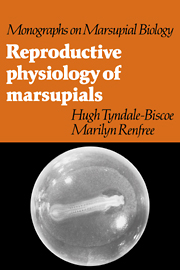Book contents
- Frontmatter
- Contents
- Preface
- 1 Historical introduction
- 2 Breeding biology of marsupials by family
- 3 Sexual differentiation and development
- 4 Male anatomy and spermatogenesis
- 5 The female urogenital tract and oogenesis
- 6 Ovarian function and control
- 7 Pregnancy and parturition
- 8 Lactation
- 9 Neuroendocrine control of seasonal breeding
- 10 Marsupials and the evolution of mammalian reproduction
- References
- Index
3 - Sexual differentiation and development
Published online by Cambridge University Press: 06 January 2010
- Frontmatter
- Contents
- Preface
- 1 Historical introduction
- 2 Breeding biology of marsupials by family
- 3 Sexual differentiation and development
- 4 Male anatomy and spermatogenesis
- 5 The female urogenital tract and oogenesis
- 6 Ovarian function and control
- 7 Pregnancy and parturition
- 8 Lactation
- 9 Neuroendocrine control of seasonal breeding
- 10 Marsupials and the evolution of mammalian reproduction
- References
- Index
Summary
Sex chromosomes
The chromosome number and morphology is known for 112 species of marsupials representing all families (see Sharman, 1973a; Hayman & Martin, 1974; Hayman & Rofe, 1977; Hsu & Benirschke, 1977). While the total DNA content of marsupial nuclei is approximately the same as those of eutherian species (Hayman & Martin, 1974), it is contained within fewer, larger chromosomes (Sharman, 1973a). The total chromosome number ranges from 2n = 10 in Wallabia bicolor to 2n = 32 in Aepyprymnus rufescens, but the distribution is bimodal around 2n = 14 and 2n = 22 (Fig. 3.1). There is lack of agreement as to which is the primitive number as species with both the modal numbers occur in South America and Australasia but there is not much doubt that 2n = 14 is the primitive karyotype for the Australian radiation from South American ancestors (Sharman, 1982). Whatever the origin may be, the large size and small number has meant that individual chromosomes, including the sex chromosomes, can usually readily be identified.
With the exception of four species, all known marsupials possess the sex chromosome pattern XY male:XX female as found in the great majority of eutherian mammals. The four exceptions have either extra X or extra Y chromosomes but their respective conditions have probably been derived from an XY:XX system by fusion of a sex chromosome with an autosome. In the macropodids Potorous tridactylus and Wallabia bicolor and in the bandicoot Macrotis lagotis the X chromosomes are large and metacentric and there are two Y chromosomes.
- Type
- Chapter
- Information
- Reproductive Physiology of Marsupials , pp. 95 - 123Publisher: Cambridge University PressPrint publication year: 1987
- 2
- Cited by



